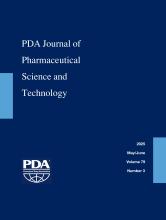Abstract
Visible particulate matter in injectables presents one important question for consideration: ″What are the potential implications to the patient?″; The risks of visible particulate matter to patient safety have been comprehensively reviewed elsewhere. However, the methods utilized to assess and characterize the risk have been explained with various degrees of specificity and supporting rationale. To date, the assessment process lacks the necessary consensus to permit a more standardized and consistent approach to evaluate the potential patient risks. The purpose of this commentary is to provide one paradigm that might be utilized to evaluate the three most relevant factors impacting the risk of injections containing particulate matter: the source of the particle; particle-specific attributes; and characteristics of the intended patient population. Each of these factors are considered with a focus on the more important aspects that might be relevant to imposing untoward risk. The discussion also includes the importance of differentiating the concepts of risk assessment from risk acceptance when establishing criticality levels for product attributes.
- Received January 25, 2018.
- Accepted July 24, 2018.
- Copyright © 2018, Parenteral Drug Association
PDA members receive access to all articles published in the current year and previous volume year. Institutional subscribers received access to all content. Log in below to receive access to this article if you are either of these.
If you are neither or you are a PDA member trying to access an article outside of your membership license, then you must purchase access to this article (below). If you do not have a username or password for JPST, you will be required to create an account prior to purchasing.
Full issue PDFs are for PDA members only.
Note to pda.org users
The PDA and PDA bookstore websites (www.pda.org and www.pda.org/bookstore) are separate websites from the PDA JPST website. When you first join PDA, your initial UserID and Password are sent to HighWirePress to create your PDA JPST account. Subsequent UserrID and Password changes required at the PDA websites will not pass on to PDA JPST and vice versa. If you forget your PDA JPST UserID and/or Password, you can request help to retrieve UserID and reset Password below.






